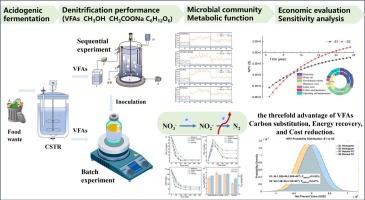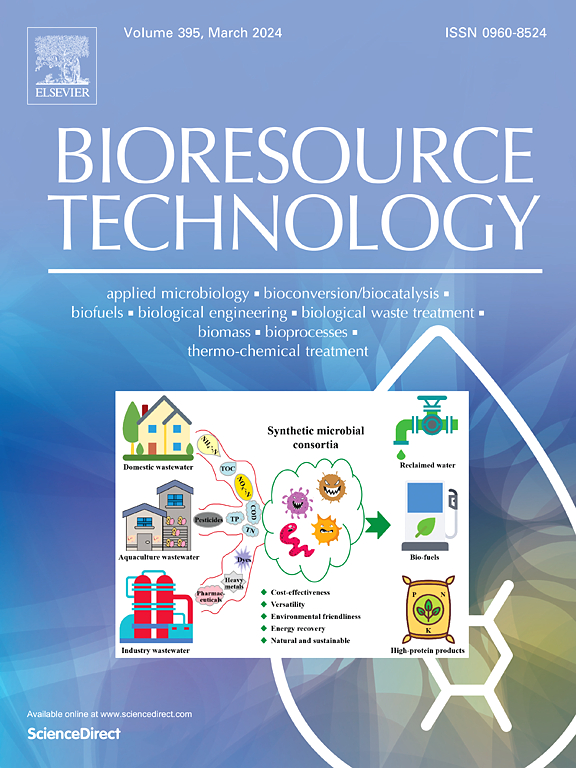食物垃圾中的挥发性脂肪酸作为外部碳源:反硝化效率、微生物途径和技术经济评估
IF 9
1区 环境科学与生态学
Q1 AGRICULTURAL ENGINEERING
引用次数: 0
摘要
从食物垃圾厌氧消化中提取的挥发性脂肪酸(VFAs)作为废水反硝化的替代外部碳源进行了系统评估。优化后的分段投加策略显著提高了VFA脱氮性能,总氮去除率达到89.16%,碳利用率高,亚硝酸盐积累最少。动力学分析表明,VFA体系的反硝化速率为7.36 mg N/(g VSS·h), COD电位为0.22 g N/g,均超过甲醇和葡萄糖体系。微生物群落分析表明,功能反硝化菌(偶氮菌和假单胞菌)丰富,代谢途径多样。工程规模的情景分析显示,长期碳成本降低了70%,内部回报率为8.5%。蒙特卡罗模拟(n = 100,000)证实了经济稳健性。这些发现表明,vfa代表了一种技术上可行、经济上可行的碳源,并为可持续废水处理方法奠定了有希望的基础。本文章由计算机程序翻译,如有差异,请以英文原文为准。

Volatile fatty acids from food waste as external carbon Sources: Denitrification Efficiency, microbial Pathways, and Techno-Economic assessment
Volatile fatty acids (VFAs) derived from the anaerobic digestion of food waste were systematically evaluated as an alternative external carbon source for wastewater denitrification. An optimized segmented dosing strategy significantly enhanced VFA denitrification performance, achieved an 89.16 % total nitrogen removal rate, demonstrated superior carbon utilization and minimized nitrite accumulation. Kinetic analysis revealed a denitrification rate of 7.36 mg N/(g VSS·h) and potential of 0.22 g N/g COD for the VFA system, both of which surpassed those of the methanol and glucose systems. Microbial community profiling indiacted the enrichment of functional denitrifiers (Azoarcus and Pseudomonas) and diverse metabolic pathways. Engineering-scale scenario analysis showed a > 70 % reduction in long-term carbon costs, an internal rate of return of 8.5 %. Monte Carlo simulations (n = 100,000) confirmed economic robustness. These findings demonstrate that VFAs represent a technically feasible, economically viable carbon source and a promising foundation for sustainable wastewater treatment methodologies.
求助全文
通过发布文献求助,成功后即可免费获取论文全文。
去求助
来源期刊

Bioresource Technology
工程技术-能源与燃料
CiteScore
20.80
自引率
19.30%
发文量
2013
审稿时长
12 days
期刊介绍:
Bioresource Technology publishes original articles, review articles, case studies, and short communications covering the fundamentals, applications, and management of bioresource technology. The journal seeks to advance and disseminate knowledge across various areas related to biomass, biological waste treatment, bioenergy, biotransformations, bioresource systems analysis, and associated conversion or production technologies.
Topics include:
• Biofuels: liquid and gaseous biofuels production, modeling and economics
• Bioprocesses and bioproducts: biocatalysis and fermentations
• Biomass and feedstocks utilization: bioconversion of agro-industrial residues
• Environmental protection: biological waste treatment
• Thermochemical conversion of biomass: combustion, pyrolysis, gasification, catalysis.
 求助内容:
求助内容: 应助结果提醒方式:
应助结果提醒方式:


